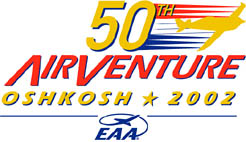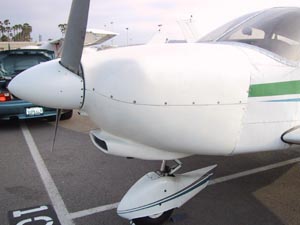
EAA AirVenture Oshkosh 2002
EAA's 50th Annual Gathering
Tuesday July 23 through Monday July 29th

| EAA AirVenture Oshkosh 2002 EAA's 50th Annual Gathering Tuesday July 23 through Monday July 29th |
|
||||||||||||
|
||||||||||||
| 'Cool Jugs’ from Liquid Cooled Air Power |
by David Sakrison |
|||||||||||
 Modern piston-powered aircraft are virtually the only vehicles left on the planet that leave the factory with air-cooled engines. Most piston engines out there are liquid-cooled, from trucks and automobiles to motorcycles and outboard motors. Most also incorporate other advanced technologies. Aircraft engines have lagged behind in technology for a host of reasons. Perhaps most important is the cost of designing and certificating a new aircraft engine design and bringing it to market. Modern piston-powered aircraft are virtually the only vehicles left on the planet that leave the factory with air-cooled engines. Most piston engines out there are liquid-cooled, from trucks and automobiles to motorcycles and outboard motors. Most also incorporate other advanced technologies. Aircraft engines have lagged behind in technology for a host of reasons. Perhaps most important is the cost of designing and certificating a new aircraft engine design and bringing it to market.
A new company called Liquid Cooled Air Power (LCAP) has taken a different, less complex, and less costly approach by applying the advantages of liquid cooling where they matter most — at the cylinders and cylinder heads. LCAP’s Cool Jugs are actually replacement cylinders for Lycoming O-360 and O-540 engines, but instead of cooling fins, each Cool Jug has a full-length water jacket that circulates coolant around the barrel and over the head of the cylinder. Cool Jugs are available for any Lycoming O-360 or O-540 on any aircraft in the experimental category. The company is planning to obtain STCs (supplemental type certificates) for both engines to allow installation of Cool Jugs in certificated aircraft. They estimate that obtaining the first STCs will take two to three years. The liquid-cooled replacement cylinders are actually half a pound lighter than finned, air-cooled cylinders. That saves 2 pounds in an O-360, 3 pounds in an O-540. The radiator, coolant pump, coolant manifold, thermostat, hoses, hardware, and liquid coolant will add about 40 pounds for a net gain of 38 pounds in a four-cylinder O-360. In exchange for the weight gain, LCAP promises longer engine life (as much as 3,000 to 5,000 hours between overhauls), more power, better fuel efficiency, and better engine reliability. In a typical O-360 or O-540, according to LCAP, most engine components are in good shape at TBO and would operate reliably for another 1,000 to 1,500 hours. Most of the wear at TBO is in the cylinder head, valve seats, and valves. Liquid cooling those components should reduce the rate of wear and increase the time between overhauls to as much as 3,000 to 5,000 hours.
Rutan mounted the radiator in his Long EZ below the engine and close to the firewall. He added a ventral scoop to the fuselage (part of the original design that was eliminated when it proved unnecessary). Drag from the scoop reduced cruise performance by 6 knots, but the Cool Jugs boosted performance to a net gain of 12 knots. The radiator is small — just 9-by-12 inches with a thickness of 3 inches, and Atkins says that is probably bigger than it needs to be. “We think we can reduce it to a 2-inch thickness. One builder has saved space by splitting the radiator in half — tucking two smaller radiators into the corners of his existing cowling.” The first Cool Jugs the company built were mounted on Atkins’ Cherokee 180. Looking at the aircraft, the first thing one notices is that the nose cowl is clean and has no intake ports — just a smooth unbroken curve from the tip of the spinner to the firewall. A small ventral scoop behind the propeller arc brings in ram air to the radiator. The drag it adds is less than what was lost when the nose bowl was smoothed out, said Atkins. Piper gives that Cherokee a maximum cruise speed of 147 mph. Atkins had already added speed modifications and a cruise prop to bring the top cruise speed to 157. With Cool Jugs installed, a new two-piece cowling, and a 4-inch prop extension, the Cherokee hit 173 mph indicated airspeed at 1,000 ft MSL — 3 mph above the never exceed speed (VNE). Atkins noted that the aircraft was well below gross max, but told AirVenture Today that even he was surprised by the performance boost. “I expected maybe 10 mph,” he said. “ I got 16 and could have gone faster, but there was that VNE.” The Cool Jugs conversion kit for the Lycoming O-360 or O-540 includes ready-to-use cylinder assemblies, intake and exhaust valves, valve seats and springs, rocker arm bushings, a top-end gasket set, and rocker box covers. The kit also includes a high-performance coolant pump, thermostat housing, coolant manifold, and cockpit gauge that shows coolant temperature and pressure and a low coolant warning light. The O-350 kit is $11,995; the O-540 kit is $15,995. LCAP is “considering” a kit for Lycoming O-320s. Rutan’s Long EZ, Atkins’ Cherokee, and the Cool Jug cylinders are on display in Booth 470 in the North Aircraft Display Area. You can inspect an O-540 with the Cool Jugs conversion at the Berkut Engineering display, Booth 120, just north of Exhibit Hangar C. For more information: www.liquidcooledairpower.com. |
||||||||||||
| EAA Aviation Center 3000 Poberezny Road Oshkosh, WI 54902 |
www.airventure.org |
All content,
logos, pictures, and videos are the property of EAA |
|